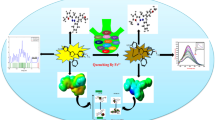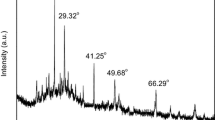Abstract
The 1,3,6,8-pyrenetetrasulfonic acid tetrasodium salt (PTSA) is a pyrene derivative with high fluorescence characteristics and is widely used in fluorescence tracer. This study aims at investigating a simple and fast fluorescence detection method for determining the concentration of ferric ion by using PTSA, which the principle is that the fluorescence quenching of PTSA by ferric ions. Theoretical and experimental methods were adopted to deeply analyze its detection performance and characteristics. The fluorescence quenching phenomena under different pH conditions and the effect of the different interfering metal ions on PTSA/Fe3+ system was studied. The results showed that the PTSA was quite promising for the fluorescence detection of trace ferric ions, and the limit of detection is 9 μg/L. This study is envisioned to provide inspirational insights on trace detection of iron ions, opening new routes for water monitoring use fluorescence properties.







Similar content being viewed by others
Data Availability
All data generated or analysed during this study are included in this published article [and its supplementary information files].
Code Availability
Not applicable.
References
Cheney K, Gumbiner C, Benson B, Tenenbein M (1995) Survival after a severe Iron poisoning treated with intermittent infusions of Deferoxamine. J Toxicol Clin Toxicol 33(1):61–66
Nayab PS, Shkir M (2017) Rapid and simultaneous detection of Cr (III) and Fe (III) ions by a new naked eye and fluorescent probe and its application in real samples. Sensors Actuators B Chem 251:951–957. https://doi.org/10.1016/j.snb.2017.05.102
Levenson CW, Cutler RG, Ladenheim B, Cadet JL, Hare J, Mattson MP (2004) Role of dietary iron restriction in a mouse model of Parkinson's disease. Exp Neurol 190(2):506–514. https://doi.org/10.1016/j.expneurol.2004.08.014
Liu YN, Zhang ZS, Xia JP (2013) Removal of Iron in nickel precipitation residue wastewater with magnesium oxide. In: Zeng JM, Zhu HX, Kong JY (eds) Advances in chemical, material and metallurgical engineering, Pts 1–5, vol 634-638. Advanced Materials Research. Trans Tech Publications Ltd, Stafa-Zurich, pp 254–257. https://doi.org/10.4028/www.scientific.net/AMR.634-638.254
Laglera LM, Monticelli D (2017) Iron detection and speciation in natural waters by electrochemical techniques: a critical review. Curr Opin Electrochem 3(1):123–129. https://doi.org/10.1016/j.coelec.2017.07.007
Radhakrishnan K, Sivanesan S, Panneerselvam P (2020) Turn-on fluorescence sensor based detection of heavy metal ion using carbon dots@graphitic-carbon nitride nanocomposite probe. J Photochem Photobiol A Chem 389:112204. https://doi.org/10.1016/j.jphotochem.2019.112204
Salahshoor Z, Ghasemi JB, Shahbazi A, Badiei A (2019) Highly selective silica-based fluorescent nanosensor for ferric ion (Fe3+) detection in aqueous media. Spectrochim Acta A Mol Biomol Spectrosc 218:293–298. https://doi.org/10.1016/j.saa.2019.03.118
Rajar K, Alveroglu E (2020) CNTs based water soluble fluorescent sensor for selective detection of Fe3+ ion. Mater Res Bull 124:110748. https://doi.org/10.1016/j.materresbull.2019.110748
Vikneswaran R, Ramesh S, Yahya R (2014) Green synthesized carbon nanodots as a fluorescent probe for selective and sensitive detection of iron(III) ions. Mater Lett 136:179–182. https://doi.org/10.1016/j.matlet.2014.08.063
Nan Z, Hao C, Zhang X, Liu H, Sun R (2020) Carbon quantum dots (CQDs) modified ZnO/CdS nanoparticles based fluorescence sensor for highly selective and sensitive detection of Fe(III). Spectrochim Acta A Mol Biomol Spectrosc 228:117717. https://doi.org/10.1016/j.saa.2019.117717
Mahajan PG, Shin JS, Dige NC, Vanjare BD, Han Y, Choi NG, Kim SJ, Seo SY, Lee KH (2020) Chelation enhanced fluorescence of rhodamine based novel organic nanoparticles for selective detection of mercury ions in aqueous medium and intracellular cell imaging. J Photochem Photobiol A Chem 397:112579. https://doi.org/10.1016/j.jphotochem.2020.112579
Yin BC, You M, Tan W, Ye BC (2012) Mercury(II) ion detection via pyrene-mediated photolysis of disulfide bonds. Chemistry 18(5):1286–1289. https://doi.org/10.1002/chem.201103348
Yang Y, Yao Z, Tang B, Yu J, Bi X, Zhao Y, Wu H-C (2014) Visual detection of cu(ii) ions based on a simple pyrene derivative using click chemistry. Anal Methods 6(14):4977–4981. https://doi.org/10.1039/c4ay00880d
Bertozo LC, Philot EA, Lima AN, de Resende Lara PT, Scott AL, Ximenes VF (2019) Interaction between 1-pyrenesulfonic acid and albumin: moving inside the protein. Spectrochim Acta A Mol Biomol Spectrosc 208:243–254. https://doi.org/10.1016/j.saa.2018.10.013
Chen W, Zheng L, Wang L, Hu S, Wu S (2019) Experimental study on interference of Fe3+ on fluorescence detection of sodium pyrene tetrasulfonate. Ind Water Wastewater 50:61–64 (in Chinese)
Liu Z, Peng J, Li W, Deng X, T-TT H (1997) Investigation of Photophysical properties of Pyrenetetrasulfonid acid Tetrasodium salt (PyTS). Chin J Luminescence 18:161–165 (in Chinese)
Wang J, Peng Y, Guo W, Ji R, Zhao L, Jia Y, Gao C (2016) Characterization of tinopal CBS-X as a fluorescent tracer in cooling water. Instrum Sci Technol 45(3):301–311. https://doi.org/10.1080/10739149.2016.1237367
Li W, Hu X, Li Q, Shi Y, Zhai X, Xu Y, Li Z, Huang X, Wang X, Shi J, Zou X, Kang S (2020) Copper nanoclusters @ nitrogen-doped carbon quantum dots-based ratiometric fluorescence probe for lead (II) ions detection in porphyra. Food Chem 320:126623. https://doi.org/10.1016/j.foodchem.2020.126623
Song J, Zhou H, Gao R, Zhang Y, Zhang H, Zhang Y, Wang G, Wong PK, Zhao H (2018) Selective determination of Cr(VI) by Glutaraldehyde cross-linked chitosan polymer Fluorophores. ACS sensors 3(4):792–798. https://doi.org/10.1021/acssensors.8b00038
Wang L, Li H, Yang Y, Zhang D, Wu M, Pan B, Xing B (2017) Identifying structural characteristics of humic acid to static and dynamic fluorescence quenching of phenanthrene, 9-phenanthrol, and naphthalene. Water Res 122:337–344. https://doi.org/10.1016/j.watres.2017.06.010
Wang L, Liang N, Li H, Yang Y, Zhang D, Liao S, Pan B (2015) Quantifying the dynamic fluorescence quenching of phenanthrene and ofloxacin by dissolved humic acids. Environ Pollut 196:379–385. https://doi.org/10.1016/j.envpol.2014.10.029
Soemo AR, Pemberton JE (2014) Combined quenching mechanism of Anthracene fluorescence by Cetylpyridinium chloride in sodium dodecyl sulfate micelles. J Fluoresc 24(2):295–299. https://doi.org/10.1007/s10895-013-1319-2
Wang J, Wang D, Miller EK, Moses D, Heeger AJ (2001) Static and dynamic photoluminescence (PL) quenching of polymer:quencher systems in solutions. Synth Met 119(1):591–592. https://doi.org/10.1016/S0379-6779(00)00643-3
Author information
Authors and Affiliations
Contributions
Guiqiao Wang: Investigation; Methodology; Roles/Writing - original draft. Xiaowei Liu: Conceptualization; Data curation; Methodology. Shaokang Cai: Writing - review & editing. Shurong Zhang: Writing - review & editing. Jinzhi Cui: Writing - review & editing. Canzhu Gao: Project administration; Resources; Supervision. Zhongfa Cheng: Resources.
Corresponding author
Ethics declarations
Conflicts of Interest/Competing Interests
The authors state that they have no known competing economic interests or personal relationships that may affect the work reported in this paper.
Additional information
Publisher’s Note
Springer Nature remains neutral with regard to jurisdictional claims in published maps and institutional affiliations.
Supplementary Information
ESM 1
(DOCX 39 kb)
Rights and permissions
About this article
Cite this article
Wang, G., Liu, X., Cai, S. et al. A Pyrene Fluorescent Probe for Rapid Detection of Ferric Ions. J Fluoresc 31, 713–718 (2021). https://doi.org/10.1007/s10895-021-02695-3
Received:
Accepted:
Published:
Issue Date:
DOI: https://doi.org/10.1007/s10895-021-02695-3




